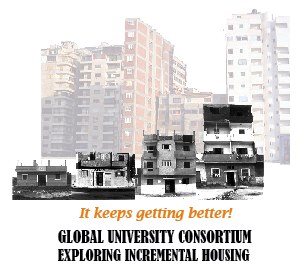
 HOW TO DO PROCESS-ORIENTED INCREMENTAL HOUSING SURVEYS, INCLUDING AN INNOVATIVE CELL PHONE INTERFACE
HOW TO DO PROCESS-ORIENTED INCREMENTAL HOUSING SURVEYS, INCLUDING AN INNOVATIVE CELL PHONE INTERFACE
Thursday, 25 March 2010, 9:00-12:00, Room W2-4
Instructors: Dr. Reinhard Goethert, Ken Griffith, Andrew Hoy
Hosted by the Global University Consortium Exploring Incremental Housing
Homebase: MIT-SIGUS
MIT Support Team: Aditi Mehta, Marium Gul, Kate Balug
Learning Objectives
• Understand the importance and the use of incremental housing strategies in city development policies by partnering
with the energies of the informal self-help housing builders.
• Be able to undertake field surveys with a process orientation for useful data capture.
• Understand technique, advantages and utility of a cell-phone 'paper-less' survey technique for use in data collection
for housing and other data-related surveys.
Presentations
• Importance of incremental housing as a policy instrument in coping with expected rapid and large growth.
• Examples of incremental self-help growth and their impact on meeting housing demands for the low income,
drawn from Egypt, El Salvador, Lima, Manila.
• Key factors for surveys: time, growth points, family size, income, and supporting intervention points
• Selection of low income housing areas representing formal housing projects, long-term stabilized squatters, upgraded
squatter settlements.
• Criteria and selection of respondents in survey
• Elements of the survey format, linked to underlying hypothesis of growth
Demonstrations
• Selecting areas to survey and determination of base map, using Google-Earth techniques
• Visual technique for selection of housing samples using photographs from low income housing areas.
• Preparing summary chart of housing expansion linking key factors
• Use of cell-phone survey approach in lieu of paper surveys
Group Exercise
• Prepare simple summary chart of key factors
• Hands-on testing of cell-phone data collection through simple illustrative housing survey
• Breakout sessions structured around main language regions: Spanish, Arabic, English to address region-specific
concerns and clarify issues.
INTRODUCTION
SUMMARY OF TRAINING SESSION
WORKSHOP EXERCISE: Family Scenarios
CELL PHONE SURVEY BACKGOUND
WORKSHOP EXERCISE: Comparative Chart

